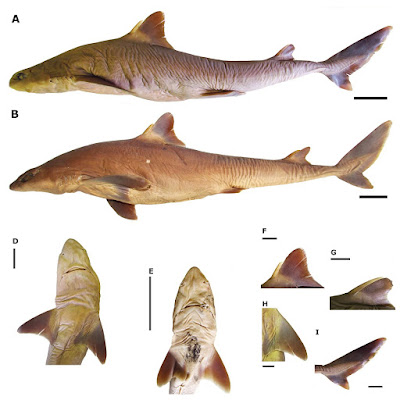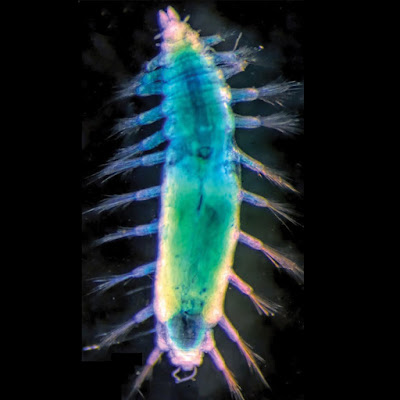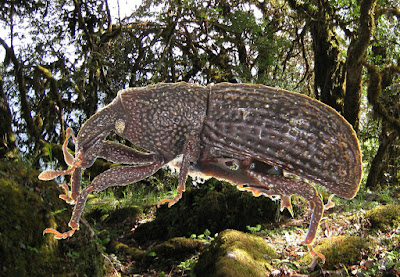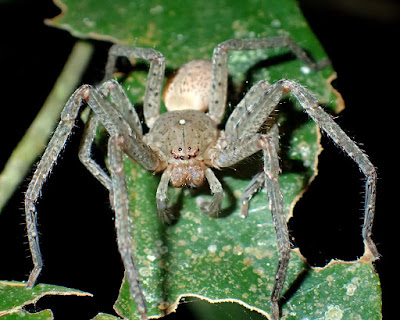[Most Recent Entries] [Calendar View]
Monday, June 15th, 2020
| Time | Event | ||||
| 7:58a | [Ichthyology • 2020] Squalus shiraii • A New Species of Dogfish Shark (Squaliformes, Squalidae) from Japan with Regional Nominal Species Revisited
Abstract A new species of deep-water dogfish shark, Squalus shiraii sp. nov., is described herein as endemic to the tropical waters off Southern Japan. This species has been largely misidentified with S. mitsukurii. However, morphological, meristic and morphometric evidence support it to be a separate and undescribed species. Squalus shiraii sp. nov. differs from this species by having body brown in colour dorsally, caudal fin with ventral and dorsal tips markedly tapered and broadly white, dermal denticles uniscuspidate and lanceolate and larger number of precaudal (91–94) and total vertebrae (120–123) (vs. body dark grey to black; caudal fin with ventral and dorsal tips rounded and not white in colour; denticles tricuspidate and rhomboid; 86–90 precaudal and 116–117 total vertebrae). Squalus shiraii sp. nov. is also clearly separated from other Japanese congeners which are herein revisited to include six species, based on the examination of over 150 specimens caught from Japanese waters that were available in ichthyological collections: S. mitsukurii, S. japonicus, S. acutirostris, S. brevirostris and S. suckleyi. Squalus mitsukurii, S. japonicus and S. brevirostris are re-described in detail and the neotype of S. japonicus is herein designated. Squalus acutirostris is treated as a valid species with occurrences in Japan, China and Taiwan and, thus, a provisional diagnosis is given, as well as an updated diagnosis of S. suckleyi. A key to Squalus species from the North-western Pacific Ocean is given and main morphological differences between S. shiraii sp. nov. and the closest related species are discussed. Key Words: taxonomy, species diversity, elasmobranch, Squalus, North-western Pacific Ocean Squalus shiraii sp. nov. Diagnosis: Single values correspond to the holotype and range to paratypes, respectively. A Squalus species that is separated from its regional congeners by: first dorsal fin conspicuously upright (vs. first dorsal fin prone); pectoral-fin posterior margin falcate (vs. not falcate); upper and lower caudal lobes markedly slender with dorsal and ventral caudal tips pointed and broadly white (vs. upper and lower caudal lobes wide with dorsal and ventral caudal tips rounded and greyish in colour); dermal denticles lanceolate, except for S. brevirostris (vs. tricuspidate); smaller claspers with clasper outer length 3.3%, 3.3%–3.4% TL and clasper inner length 6.3%, 5.9%–6.3% TL (vs. 4.5%–4.9% TL, 6.9%–8.4% TL for S. mitsukurii vs. 4.8%, 4.3%–5.6% TL and 7.5%, 7.2%–9.1% TL for S. japonicus; vs. 3.9%, 3.9%–5.1% TL and 7.1%, 7.0%–8.1% TL for S. brevirostris). Squalus shiraii sp. nov. further differentiates from S. mitsukurii by more elongate eyes, its length 4.9%, 4.4%–4.9% TL (vs. 3.6%, 3.1%–4.0% TL) and smaller fifth gill slit, its length 1.7%, 1.7%–2.1% TL (vs. 2.3%, 2.2%–2.6% TL). It is separated from S. japonicus and S. brevirostris by prenarial length 5.5%, 5.4%–5.6% TL (vs. 5.9%, 5.9%–6.8% TL for S. japonicus vs. 4.0%, 3.8%–4.3% TL for S. brevirostris) and width of first dorsal-fin spine 0.9%, 0.9%–0.9% TL (vs. 0.7%, 0.5%–0.8% TL for S. japonicus vs. 0.7%, 0.5%–0.7% TL for S. brevirostris). Squalus shiraii sp. nov. further differs from S. japonicus by shorter snout, its preorbital length 7.9%, 7.4%–7.9% TL (vs. 8.7%, 8.7%–9.3% TL for S. japonicus), smaller preoral length 10.4%, 9.4%–10.4% TL (vs. 10.7%, 10.7%–12.2% TL), larger first dorsal fin, its base length 7.7%, 7.7%–8.7% TL and first dorsal-fin posterior margin length 9.2%, 9.0%–9.3% TL (vs. 6.7%, 6.6%–7.5% TL and 7.8%, 6.7%–8.6% TL for S. japonicus) and wider pectoral fin, its posterior margin length 10.0%, 10.0%–11.7% TL (vs. 8.6%, 7.8%–9.2% TL). It is separated from S. brevirostris by wider internarial space, its width 4.8%, 4.1%–4.8% TL (vs. 3.6%, 3.4%–3.8% TL for S. brevirostris), smaller second dorsal fin with inner margin length 3.6%, 3.2%–4.1% TL (vs. 5.0%, 4.8%–5.7% TL), shorter pectoral-fin inner margin, its length 7.3%, 7.3%–8.3% TL (vs. 10.3%, 9.8%–11.2% TL) and narrower caudal fin, its width at caudal fork 6.4%, 5.7%–6.4% TL (vs. 6.6%, 6.6%–7.3% TL). Squalus shiraii is distinguished from S. formosus regardless of maturity by having more elongate precaudal (78.3%, 78.6%–80.5% TL), pre-second (60.5%, 61.1%–63.4% TL) and pre-first (30.5%, 29.6%–31.2% TL) dorsal length (vs. 77.6%–78.3% TL, 59.4%–59.7% TL and 28.1%–29.0% in S. formosus). Etymology: This species is named after Dr. Shigeru M. Shirai, Japanese ichthyologist from Tokyo University of Agriculture, for his valuable contributions to Systematics of Squaliformes. Vernacular: Shirai’s Spurdog; Hiretaka-tsunozame (Japanese). Geographical distribution: This species is apparently a Japanese endemic, occurring in the shallow waters of the upper continental slope off Southern Japan in the North-western Pacific Ocean at 310–390 m depth (Fig. 8A). Sarah T. F. L. Viana and Marcelo R. de Carvalho. 2020. Squalus shiraii sp. nov. (Squaliformes, Squalidae), A New Species of Dogfish Shark from Japan with Regional Nominal Species Revisited. Zoosystematics and Evolution. 96(2): 275-311. DOI: 10.3897/zse.96.51962 | ||||
| 8:02a | [Mammalogy • 2020] Laonastes aenigmamus • Using Radiotelemetry to Identify the Home Range and Daily Movement of A “Living Fossil”: the Laotian Rock Rat
Abstract The Laotian rock rat or Kha nyou (Laonastes aenigmamus) is a small mammal species that was discovered in Central Lao People's Democratic Republic (Lao PDR) in 1996. After this discovery, the Laotian rock rat was recognized as a living fossil of the family Diatomyidae, other members of which have been extinct more than 11 million years. Previous studies have been limited to the taxonomy of the species, but information on its behavior and ecology is still lacking. Our study on home range size and movement distances of the Laotian rock rat was conducted using radio tracking in Mouang-doy village, Phou Hin Poun National Biodiversity Conservation Area, central Lao PDR. We equipped four live-trapped Laotian rock rats (3 males and 1 female) with radio collars between December 2009 and January 2011. Radio-collared animals were tracked every thirty minutes and for at least five consecutive days per month. The averaged home ranges of the Laotian rock rat in the dry season and in the wet season were 1.69 ha (SD = 0.53; n = 4) and 1.49 ha (SD = 0.46; n = 3), respectively, and were not significantly different. The home ranges of radio-collared Laotian rock rats overlapped among individuals, and overlapped area between pairs of animals ranged from 30.21 to 75.89%. The mean daily movement distances were 1602 m (SD = 150.13; n = 3 individuals) and 1578 m (SD = 52; n = 3 individuals) for the dry season and the wet season, respectively, with no statistically significant difference. This study also indicated that the Laotian rock rat is cathemeral. We would suggest additional studies to better understand the behavioral ecology of the Laotian rock rats, especially with regards to the comparison between sexes and social organization. Keywords: Kha nyou, Laonastes aenigmamus, Phou Hin Poun, Laos Thananh Khotpathoom, Thinh Tien Vu, Naris Bhumpakphan, Ronglarp Sukmasuang and Sara Bumrungsri. 2020. Using Radiotelemetry to Identify the Home Range and Daily Movement of A “Living Fossil”: the Laotian Rock Rat (Laonastes aenigmamus). Mammalian Biology. DOI: 10.1007/s42991-020-00039-5 ຫນູ ຂະຍຸ ເປັນສັດ ປະເພດກັດແຫ້ນ ແຕ່ກີນພືດເປັນຫລັກ ແລະ ພວກມັນຈະກະຈາຍ ຢູ່ສະເພາະແຕ່ ໃນເຂດພູຫີນປູນ. ມັກທີ່ແຫ້ງ ແລະ ສະອາດ ມີຂອບເຂດ ຫາກີນບໍ່ກ້ວາງ (ປະມານ ເຮັກຕາປາຍ ໃນຮອບຫນຶ່ງປີ) ແລະ ຈະອອກຫາກີນ ຕະຫລອດ ທັງເວັນ ແລະຄືນ ຂຶ້ນກັບ ທ້ອງຂອງພວກມັນຫວ່າງຍາມໃດ ຊຶ່ງຈະຄ້າຍໆກັບສັດ ກິນພືດ ໂດຍທົ່ວໄປ ເພາະພວກມັນ ຄື ສັດກີນພືດ ແລະ ຄ້ຽວເອື້ອງ ນັ້ນເອງ. | ||||
| 8:14a | [Invertebrate • 2020] Anguillosyllis (Annelida: Syllidae) from Multiple Deep-water Locations in the Northern and Southern Hemispheres
Abstract Numerous specimens belonging to the syllid genus Anguillosyllis Day were collected during several deep-sea studies conducted between 1970 and 2011 in depths ranging from 180 to nearly 5000 m. These quantitative studies demonstrated that members of this genus are not as uncommon as once thought but can be among the 10 most common infaunal species at some deep-sea locations. Study areas included Georges Bank (New England), the North, Mid, and South Atlantic Continental Slope and Rise (east coast of North America), the Gulf of Mexico (off Louisiana), off San Francisco, California, the Clarion-Clipperton Fracture Zone (Pacific Ocean), the South China Sea (off Brunei), the abyssal plain in the South Atlantic Ocean, and Antarctica (Scotia Sea, Weddell Sea). Sixteen new species are described, bringing the total number of described Anguillosyllis species to 20; one additional species that cannot be fully characterized is also noted. The new species include eight with palps that are entirely or partially free (Anguillosyllis aciculata n. sp., A. acsara, n. sp., A. carolina n. sp., A. denaria n. sp., A. hadra, n. sp., A. hampsoni n. sp., A. taleola n. sp., and A. truebloodi n. sp.) and eight species with completely fused palps (A. andeepia n. sp., A. blakei n. sp., A. bruneiensis n. sp., A. elegantissima n. sp., A. enneapoda n. sp., A. hessleri n. sp., A. inornata n. sp., and A. sepula n. sp.). Type specimens of A. palpata (Hartman) from off Cape Horn and A. pupa (Hartman) from off New England were examined; A. capensis Day from South Africa and A. lanai Barroso, Paiva, Nogueira & Fukuda from Brazil are discussed. All adult Anguillosyllis have a fixed number of setigers, either 8, 9, 10, or 11, with 11 setigers being the most common. Species differ in the number of setigers, degree of fusion of the palps, degree of development of parapodial lobes, structure and number of internal and external glands, number of setae in anterior setigers, shape and size of proventricle, and annulation of the dorsum. All species for which the anal cirri had not been lost were found to have four, including two long, thin, ventromedial ones and two shorter, usually oval, lateral ones. Reproduction is poorly known in the genus; the present study shows eggs are found in the posterior (post-proventricle) setigers of most species and enter the parapodia from the coelom of several specimens; egg diameters generally ranged from 50–85 µm with A. sepula n. sp. having eggs up to 120 µm, the largest reported for the genus. Keywords: Annelida, ANDEEP, Antarctica, Atlantic Continental Slope and Rise, benthos, Borneo, Brunei, Clarion-Clipperton Fracture Zone, deep-sea, Georges Bank, New England, SF-DODS, South China Sea
Nancy J. Maciolek. 2020. Anguillosyllis (Annelida: Syllidae) from Multiple Deep-water Locations in the Northern and Southern Hemispheres. Zootaxa. 4793(1); 1-73. DOI: 10.11646/zootaxa.4793.1.1 | ||||
| 8:29a | [Entomology • 2020] Revision of the Nepalese Genus Microplinthus Zherichin, 1987 (Coleoptera: Curculionidae: Molytinae), with Description of 25 New Species
Abstract The Nepalese genus Microplinthus Zherichin, 1987 is revised. The following 25 new species are described (type locality in parentheses): M. annapurnae (Annapurna Himal, Rambrong Danda), M. arunensis (Khandbari Distr., forest S. Mansimgma), M. brevipennis (Manaslu Himal, Bhara Pokhari), M. durga (W Pokhara, near Ghorepani), M. franzi (Kaligandakhi valley, between Lethe and Tukuche), M. ganesha (Ganesh Himal, Rupchet), M. godawaricus (Kathmandu, Phulchowki), M. gupta (Helambu Himal, upper Chipling), M. helambuensis (Central Nepal, between Mulkharka and Thare Pati), M. jaegeri (W Pokhara, Mt. Panchase), M. karnalicus (Karnali Distr. 5 km E Charta), M. kaskianus (Kaski Distr., above Pothana), M. kaumarya (Karnali Distr., Gotichaur valley), M. khandbariensis (Khandbari Distr., above Seduwa), M. koshianus (Koshi Prov., SW Chichilla), M. letheensis (Kaligandakhi valley, between Lethe and Tukuche), M. longipennis (Manaslu Himal, Bhara Pokhari lekh), M. messneri (Panchtar Distr., Dhorpar Kharka), M. newarorum (Phulchowki Distr., Lalitpur), M. phulchowkianus (Kathmandu, Phulchowki), M. rugosus (Solokhumbu Distr., Lamiura Danda), M. schmidti (Manaslu Himal, Dudh Pokhari lekh), M. sherpa (Khandbari Distr., Bakan), M. tamanus (Rolwaling Himal, upper Simigau), M. yeti (Hinku Distr., Drangka Khola bridge). A key for the identification of all species of Microplinthus is given. A phylogenetic analysis based on morphological characters of the species referable to the genera Falsanchonus, Microniphades and Microplinthus was carried out, implementing Bayesian Inference and Maximum Parsimony. Results indicate that the genera Falsanchonus and Microniphades are paraphyletic and are here treated as junior synonyms of Microplinthus. Keywords: Coleoptera, Phylogeny, new species, taxonomic revision, Himalayan fauna, weevils, synonymy, species discovery
Massimo Meregalli. 2020. Revision of the Nepalese Genus Microplinthus Zherichin, 1987 (Coleoptera: Curculionidae: Molytinae), with Description of 25 New Species. Zootaxa. 4794(1); 1–63. DOI: 10.11646/zootaxa.4794.1.1 | ||||
| 8:58a | [Arachnida • 2020] Thunberga gen. nov. • A New Genus of Huntsman Spiders (Araneae: Sparassidae: Heteropodinae) from Madagascar
Abstract A new genus of the family Sparassidae is described from Madagascar: Thunberga gen. nov. It can be distinguished from other genera of the Heteropodinae by its different cheliceral dentition and eye arrangement as well as by its uniquely dotted prosoma. Four species are transferred to the new genus: T. hildebrandti (Järvi, 1912) comb. nov. (from Rhitymna Simon, 1897a), T. malagassa (Strand, 1907) comb. nov. (from Olios Walckenaer, 1837), T. nossibeensis (Strand, 1907) comb. nov. (from Olios), T. septifer (Strand. 1908) comb. nov. (from Olios, elevated to species rank). T. hildebrandti comb. nov. is recognised as junior synonym of T. nossibeensis comb. nov. One species is described for the first time: Thunberga greta spec. nov. (female, Madagascar). The systematic placement within the family and the character “anterior epigynal pocket” are discussed. Keywords: Araneae, Taxonomy, systematics, copulatory organs, transfers, first description, Africa
Thunberga gen. nov. Type species. Thunberga nossibeensis (Strand, 1907) comb. nov. Etymology. Named after Greta Thunberg (*2003 in Sweden), a young and courageous climate activist fighting against global warming, ignorant stakeholders and for a better future on our planet. In fact, global warming and other issues caused by humans affect all parts of the nature including Madagascar’s nature in general and its spider fauna in particular. Gender is feminine. Species included. Thunberga greta spec. nov., T. malagassa (Strand, 1907) comb. nov., T. nossibeensis (Strand, 1907) comb. nov., T. septifer (Strand, 1908) comb. nov. Natural History. Nothing is known so far about the natural history of species of this new genus. No information on labels were available either. Roger (2018: fig. 20d) published a photo of a spider most likely belonging to Thunberga gen. nov. If so, it might well be that those spiders are nocturnal hunters in the foliage (Roger mentions ylang-ylang trees in Combani). Distribution. Madagascar and neighbouring islands (St. Marie, Nosy Be) (Fig. 47), most likely occurring also on Mayotte (see Roger 2018: fig. 20d). Peter Jäger. 2020. Thunberga gen. nov., A New Genus of Huntsman Spiders from Madagascar (Araneae: Sparassidae: Heteropodinae). Zootaxa. 4790(2); 245–260. DOI: 10.11646/zootaxa.4790.2.3 A spider named Greta New species of spiders described in honour of Swedish climate activist |
| << Previous Day |
2020/06/15 [Calendar] |
Next Day >> |















